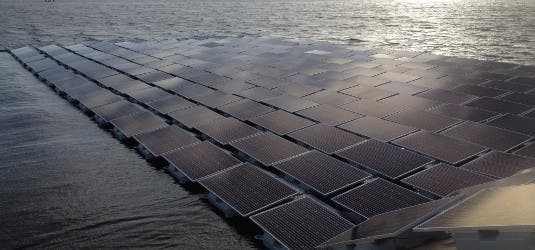The largest floating solar array in the world is to be unveiled later this month, on the Queen Elizabeth II reservoir, at Walton-on-Thames. The array is estimated to generate almost 6 million kWh in its maiden year of operations. The energy will be used to power London’s water treatment plants.
Ennoviga Solar and Lightsource Renewable Energy workers are busy getting the largest floating solar array ever built ready for its big unveiling, scheduled early March this year. The £6m (US$8.5m) project was commissioned by Thames Water five years ago, as part of the company’s pledge towards a more sustainable business model — their goal is to supply 33% of their energy requirements from clean sources by 2020.

Image via pv-magazine.
“Over the last five years we have successfully completed ground and roof installations of all shapes and sizes, but this project has some obvious differences and has presented our team with a set of fresh challenges to overcome,” said Lightsource CEO Nick Boyle.
Thames Water has already set-up 41 other solar-panel sites which cover 12.5% of their needs. But the company knew it had to go big to reach such a hefty goal — and with the Queen Elizabeth II reservoir array they went full out.
The QEII array consists of 23,000 solar photovoltaic panels perched atop 61,000 floating platforms, with everything held tidy in place by 177 anchors. The final structure covers roughly 128.3 hectares in size (or ~6% of the reservoir’s surface) with a perimeter of 4.3km. It has a projected capacity of 6.3 MW, able to generate around 5.8 million kWh during the first year of its operation. All this power will help provide clean drinking water to a populace of close to 10 million people in greater London and the south-east of England, a huge and often unrecognized drain on electricity, rather than nearby homes.
Officials noted that floating arrays have several advantages over their land-lubber counterparts. Firstly, they’re cheaper to build, as panels can be constructed on individual platforms and then attached to the main structure and anchored. They use space that would otherwise just go to waste and is dirt-cheap compared to regular dirt — and as a bonus, that land remains free to use for other resources. But most importantly, the water body’s cooling effect reduces maintenance hours and costs for the panels, meaning more power at a lower price.
The floating array uses a mounting system developed by Ciel et Terre, which has been pivotal in providing floating technology that has brought buoyancy to a relatively new section of the solar industry.
“This is our largest project outside of Japan and the first one with European bank financing, proving that our technology is not only suitable for water utilities, but has also been recognized as bankable in Europe as well as Asia,” said Ciel et Terre international business development director Eva Pauly.
In the case of the QEII project, the array also shields the water from the sun reducing algae growth, a problem that reservoir staff has had to deal with before.
The array’s record however will be overtaken by other projects already under construction (such as Japan’s massive array that will be completed in 2018.) But officials wish them the best of luck, noting they are proud to be leading the way and hope others will be inspired by what they have created.
“This will be the biggest floating solar farm in the world for a time – others are under construction,” said Angus Berry, energy manager for Thames Water, which owns the site. “We are leading the way, but we hope that others will follow, in the UK and abroad.”





